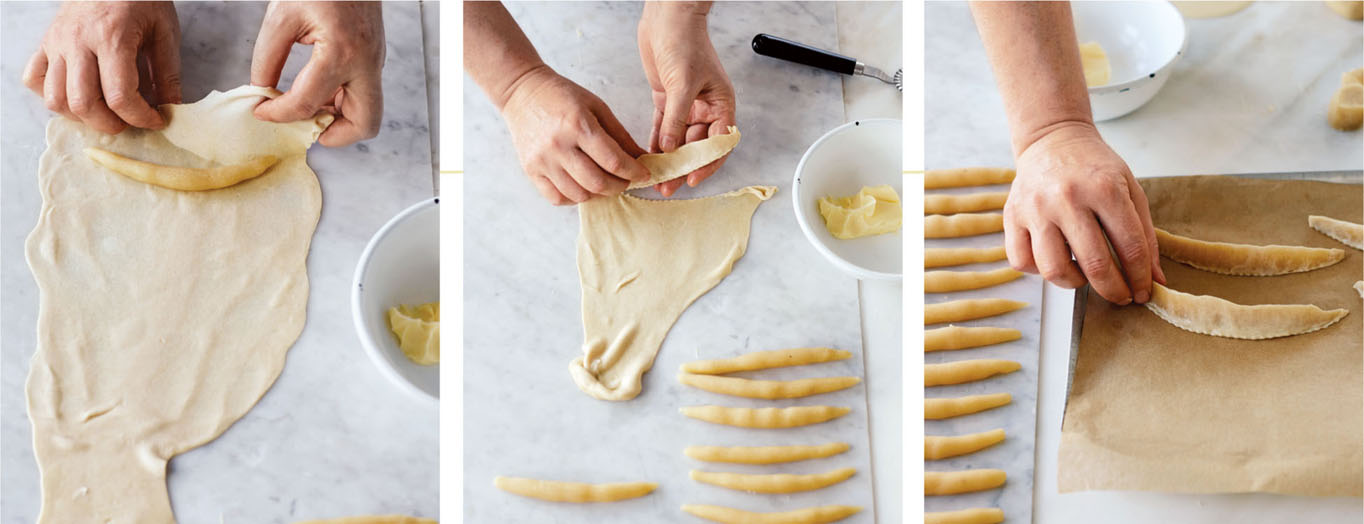QA’B EL-GH’ZAL
MOROCCO

The most elegant of all Moroccan pastries, cornes de gazelles (meaning “the horns of a female deer”) are a labor of love as they are time-consuming to prepare. Still, they are definitely worth making. They are among the most elegant and most delicious of all North African sweet confections. They are the first treat I buy when I visit Morocco, and it is rare for a day to go by when I am there without having some, usually with mint tea. It is not often that you will find them prepared in the same delicate way in the West. Most of those you buy in pastry shops outside Morocco are too coarse with a very thick pastry and bland filling. The only way you are going to have them as delicate and tasty as those made in Morocco is by making them yourself, or by having them in a Moroccan home where they’ve been made.
MAKES ABOUT 20
FOR THE FILLING
1⅔ cups (250 g) blanched almonds, soaked for 1 hour in boiling water
½ cup plus 1 tablespoon (75 g) powdered sugar
2 tablespoons orange blossom water
1 tablespoon unsalted butter, at room temperature
¼ teaspoon ground mastic (see Glossary)
FOR THE DOUGH
1 cup (120 g) unbleached all-purpose flour
1 tablespoon unsalted butter, melted
2 tablespoons orange blossom water
Softened butter, for shaping
1. To make the filling: Drain the almonds and spread them to dry on a clean kitchen towel.
2. Put the almonds in a food processor along with the powdered sugar and process until very fine. Transfer to a bowl. Add the orange blossom water, butter, and mastic and mix with your hands until you have a homogeneous paste. Cover with a clean kitchen towel.
3. To make the dough: Put the flour in a shallow medium mixing bowl and make a well in the center. Add the melted butter and orange blossom water to the well and gradually add 3 tablespoons water, working the liquid into the flour with your hand.
4. Transfer the dough to a work surface and knead for 3 minutes. Shape the dough into a ball, invert the bowl over the dough, and let rest for 15 minutes. Knead for 3 more minutes, or until the dough is smooth and elastic and quite soft.
5. Divide the almond filling into 20 portions. Roll each into a ball, then into a small sausage about 4 inches (10 cm) long. Taper the ends of each almond roll.
6. Preheat the oven to 400°F (200°C).
7. Smear your pastry board, rolling pin, and hands with a little butter. Take a piece of dough and roll it out, turning it over once or twice, until very thin and about 5 inches (12.5 cm) wide. Carefully stretch the dough with your hands to widen and thin it a little more. With the 5-inch (12.5 cm) side facing you, place an almond paste sausage crosswise about ¾ inch (2 cm) up from the edge. Pull the dough up and over the sausage and press tightly around the almond roll, encasing it. Pinch the filling and dough along the top to make a ridge and at the same time, bend it into a crescent with pointed ends (like a gazelle horn). Press the dough together at the seam and cut, following the shape of the crescent, using a fluted pastry wheel. The crescent should measure about 4 inches (10 cm) long and 1¼ inches (3 cm) high. Prick with a toothpick in several places on both sides, to stop it from puffing up, and place on a nonstick baking sheet (or a regular baking sheet lined with parchment paper or a silicone baking mat). Repeat to make 20 crescents.

8. Bake for 10 minutes, or until they are barely colored. Transfer the pastries to a wire rack to cool before serving. They will keep for at least 1 week in an airtight container.